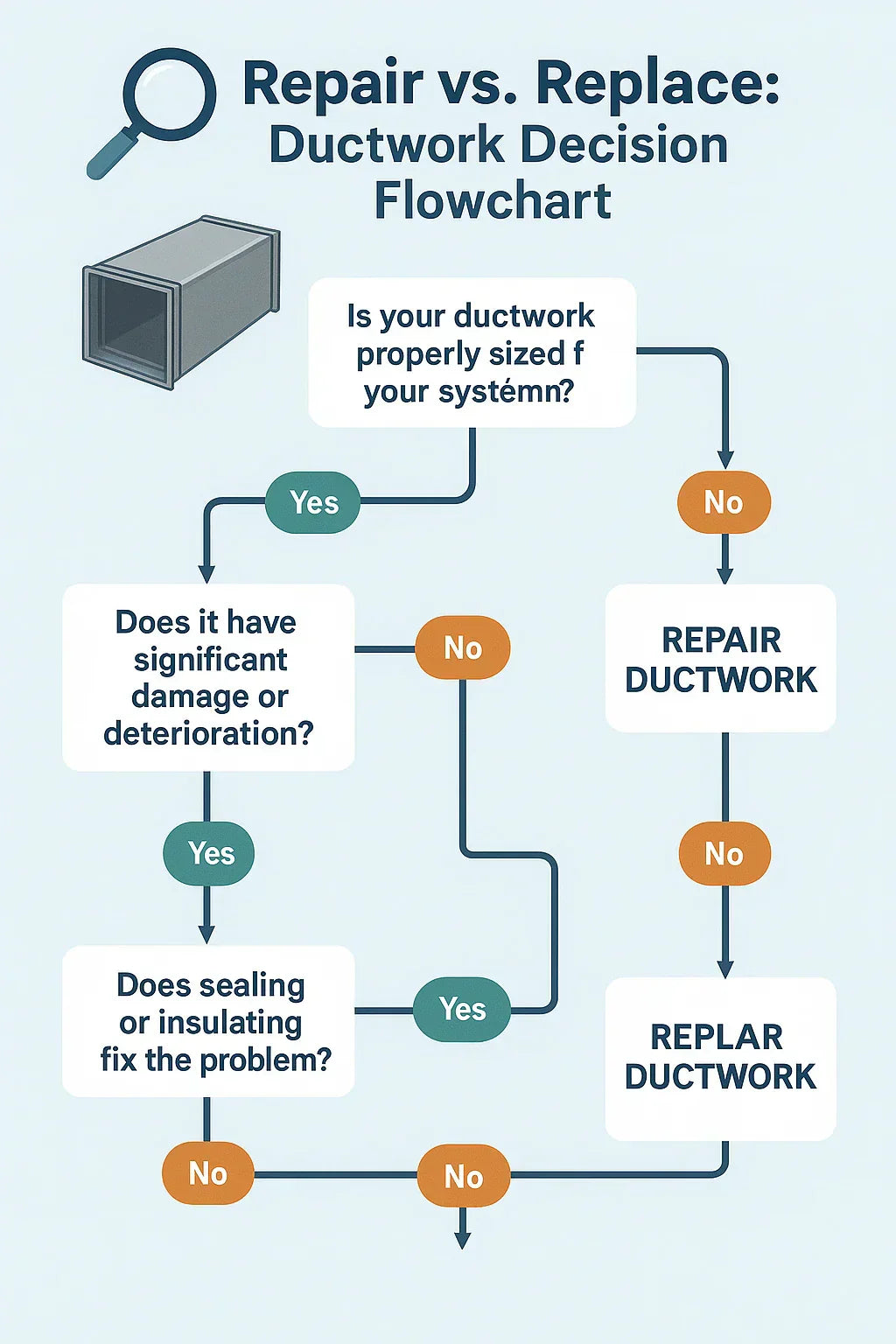📖 Introduction: Why Your Ducts Are Just as Important as Your Furnace & AC
When most people upgrade to a 30,000 BTU furnace & AC combo, they’re excited about the new equipment—brand-new coils, high SEER2 efficiency ratings, maybe even smart thermostat integration. But here’s something I’ve seen over and over in my years helping folks choose and install HVAC systems: the ductwork can make or break your investment.
I’m Jake. I’ve been elbows-deep in enough crawlspaces and attics to know—your ducts aren’t just pipes in the walls. They’re the highway for all that conditioned air you’re paying for. If the highway’s clogged, full of leaks, or the wrong size, your shiny new system won’t deliver.
In this guide, we’ll cover everything you need to know about ductwork when pairing it with a 30k BTU system, from how it works to when it’s time to replace it—plus cost breakdowns, tests, and my personal checklist.
🌀 Section 1 – Understanding the Basics of Ductwork
What Ductwork Does
Ductwork is the network of pathways that deliver heated or cooled air from your furnace or AC into the living spaces of your home, and then return it for reconditioning.
Two main parts:
-
Supply ducts – Carry conditioned air into rooms.
-
Return ducts – Pull air back to the system for reheating or cooling.
The design, size, and condition of this network are crucial for comfort and efficiency. According to the U.S. Department of Energy (DOE), leaky or poorly designed ducts can reduce heating and cooling efficiency by up to 30%.
📏 Section 2 – Matching Duct Size to a 30,000 BTU System
A 30k BTU air conditioner typically moves 1,000–1,200 cubic feet of air per minute (CFM). That airflow needs to travel through ducts sized for that capacity. Undersized ducts cause excessive static pressure, which can:
-
Reduce airflow to rooms.
-
Overwork the blower motor.
-
Shorten system lifespan.
Manual D – The Gold Standard
In professional HVAC design, Manual D is the calculation method for duct sizing (Air Conditioning Contractors of America – ACCA). It factors in:
-
CFM needs.
-
Duct length.
-
Number of bends.
-
Friction loss from materials.
If you’re reusing old ducts, have a pro verify the sizing before you connect your new 30k BTU combo.
🚩 Section 3 – Signs Your Ductwork Needs Replacement
You might not need all new ducts—but these are the red flags I look for:
-
Uneven Temperatures
-
Some rooms too hot, others too cold.
-
-
Weak Airflow
-
Feels like the air is barely trickling from vents.
-
-
Noisy Ducts
-
Whistling, rattling, or booming sounds when the blower kicks on.
-
-
High Dust Levels
-
Dust buildup faster than normal, even with regular filter changes.
-
-
Visible Damage
-
Rust, holes, disconnected runs.
-
-
Old Materials
-
Fiberglass duct board that’s deteriorating, or collapsed flex duct.
-
🔧 Section 4 – When Repairs Are Enough
Not every duct issue means a total replacement. You can often improve performance with:
-
Sealing Leaks – Use mastic or UL 181 foil tape (never standard duct tape—it fails fast). Energy Star estimates sealing can save up to 20% on energy bills.
-
Adding or Enlarging Returns – Helps balance airflow.
-
Insulating Ducts – Especially if they run through unconditioned spaces like attics.
🛑 Section 5 – When Replacement Is the Best Option
Sometimes it’s just not worth patching. I recommend full replacement if:
-
Ducts are undersized for the new system.
-
Layout is too restrictive for proper airflow.
-
Materials are damaged beyond repair.
-
There’s significant mold contamination.
-
Leakage rates are extremely high (over 20% of airflow lost).
💰 Section 6 – Cost of New Ductwork in 2025
Here’s a breakdown for a 30k BTU system:
| Material | Cost per Linear Foot | Pros | Cons |
|---|---|---|---|
| Flex Duct | $5–$9 | Easy install, cheaper | Can collapse, higher friction loss |
| Sheet Metal | $9–$15 | Durable, smooth airflow | More labor-intensive install |
Whole-home replacement:
-
Simple single-story layout: $3,000–$5,000
-
Complex/multi-story: $5,000–$8,000+
Cost Factors:
-
Accessibility (attic vs. crawlspace).
-
Labor rates in your area.
-
Material choice.
📉 Section 7 – How Bad Ducts Kill Efficiency
Leaky ducts are silent bill-killers. According to ENERGY STAR, the average home loses 20–30% of conditioned air through leaks.
What that means for your 30k BTU system:
-
A high-efficiency 17 SEER2 system could effectively perform like a 13 SEER2 once those losses are factored in.
-
Your blower will run longer, using more electricity.
-
Comfort suffers—rooms never quite hit the set temperature.
🧪 Section 8 – Testing Your Ducts
Before replacing, test:
-
Blower Door Test – Measures whole-house air leakage
-
Duct Blaster Test – Pressurizes the ducts to pinpoint leaks.
-
Thermal Imaging – Finds temperature losses through duct walls.
Professional duct testing costs $300–$500 but can save thousands in unnecessary replacement.
📝 Section 9 – Jake’s Installer Questions
When getting quotes, ask:
-
Are my ducts sized right for 1,000–1,200 CFM?
-
What’s my duct leakage rate?
-
Can sealing and insulation bring them up to standard?
-
How many returns do I have, and are they sized correctly?
-
Can we replace only problem sections?
-
Will new ducts significantly improve efficiency and comfort?
📚 Section 10 – Verified Resources for Further Reading
✅ Section 11 – Conclusion
Your ductwork is just as important as your 30k BTU combo system. If it’s too small, leaky, or poorly laid out, you’ll never get the performance you paid for.
Before you commit to a new install:
-
Inspect and test your ducts.
-
Compare repair vs. replacement costs.
-
Make sure any new ducts are designed for your system’s airflow.
In the next article we will know more about: Maintaining Your 30,000 BTU Furnace/AC System for Peak Performance







